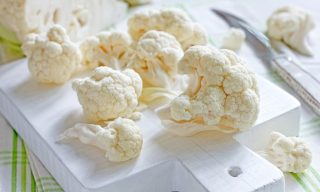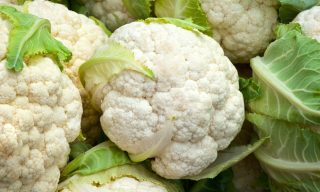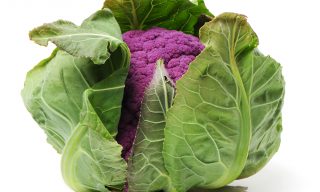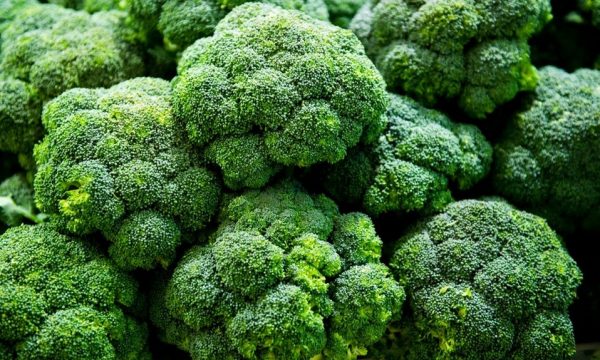We know it’s sad, but all good things must come to an end. Thankfully, your favorite cruciferous veggies are still in season, but our final post in spotlighting fresh, fall cruciferous vegetables is here. Don’t worry though. We’re going to end things with a BANG and talk about the grand finale….Cauliflower!
 The botanical name for cauliflower is Brassica Oleracea and the name cauliflower itself comes from a combination of “coulis,” the Latin word for cabbage, and flower. Cauliflower is believed to have originated in Cypress as early as the 6th century B.C. In the 12th century, cauliflower was introduced to Spain, and by the 16th century, it was available in England and France as well. Cauliflower was especially popular in the Court of Louis XIV. By the late 18th century as methods of cultivation improved, the use of cauliflower throughout Europe became more widespread. However, it was not until the 20th century that cauliflower started being cultivated in the United States.
The botanical name for cauliflower is Brassica Oleracea and the name cauliflower itself comes from a combination of “coulis,” the Latin word for cabbage, and flower. Cauliflower is believed to have originated in Cypress as early as the 6th century B.C. In the 12th century, cauliflower was introduced to Spain, and by the 16th century, it was available in England and France as well. Cauliflower was especially popular in the Court of Louis XIV. By the late 18th century as methods of cultivation improved, the use of cauliflower throughout Europe became more widespread. However, it was not until the 20th century that cauliflower started being cultivated in the United States.
Cauliflower Nutritional Benefits
 Cauliflower is very low in calories but packed with fiber and other health-promoting nutrients, such as vitamins C and K and folate. Cauliflower contains other B complex vitamins as well, along with the essential minerals manganese, potassium, phosphorus, and magnesium. Cauliflower also contains many cancer-fighting phytonutrients such as carotenoids and glucosinolates, and enzymes that help flush out toxins from the body.
Cauliflower is very low in calories but packed with fiber and other health-promoting nutrients, such as vitamins C and K and folate. Cauliflower contains other B complex vitamins as well, along with the essential minerals manganese, potassium, phosphorus, and magnesium. Cauliflower also contains many cancer-fighting phytonutrients such as carotenoids and glucosinolates, and enzymes that help flush out toxins from the body.
Cauliflower Varieties Today there are many different varieties of cauliflower. Most of the cauliflower we eat here in the U.S. are white, but cauliflower is also available in other colors like orange, purple, and green. Orange cauliflower, which originated in Canada, is milder in flavor than white cauliflower. It is especially rich in vitamin A and beta-carotene. Purple cauliflower is not only beautiful to look at but very high in anthocyanins, which function as powerful antioxidants. Cauliflower that is green in color is actually a hybrid of white cauliflower and broccoli and therefore often called “Broccoflower.” Like the other colorful cauliflowers, it is milder in taste than white cauliflower.
Cauliflower Season
Like fresh broccoli, fresh cauliflower can be purchased year-round. However, its peak quality and flavor is in the colder months. During the off-season, frozen cauliflower is an acceptable substitute.
Cauliflower Selection and Storage
 When shopping for cauliflower, clean looking heads that are heavy for their size with compact curds are what you want. Although the leaves aren’t edible, the presence of many thick green leaves helps protect the plant and ensure freshness. White cauliflower should be creamy white, while the colored varieties don’t necessarily need to be brightly hued, but their color should be uniform. Your best bet for finding high quality colored cauliflower is your local farmers market. Avoid cauliflower heads with small flowers or any blemishes or brown spots, which are signs of age.
When shopping for cauliflower, clean looking heads that are heavy for their size with compact curds are what you want. Although the leaves aren’t edible, the presence of many thick green leaves helps protect the plant and ensure freshness. White cauliflower should be creamy white, while the colored varieties don’t necessarily need to be brightly hued, but their color should be uniform. Your best bet for finding high quality colored cauliflower is your local farmers market. Avoid cauliflower heads with small flowers or any blemishes or brown spots, which are signs of age.
Cauliflower is sturdy, but like other vegetables, it still needs to be stored properly to stay fresh and not lose its valuable nutrients. Cauliflower continues to respire after harvesting. Therefore, if it is not going to be eaten right away, it should be placed, unwashed, in an airtight plastic bag, and then stored in the refrigerator. Stored in this manner, a whole head should remain fresh for up to a week and a partial head for a couple of days. Washing the cauliflower just before preparing it for serving, and not any sooner, will also prolong its freshness.
Cauliflower Recipes
Cauliflower can be enjoyed in a variety of ways. It can be served raw, as a crudité with other raw veggies like broccoli and carrots, or as part of a salad. Cauliflower also tastes great cooked, not only as a side dish for dinner, but also in soups, casseroles, and stir-fries. However, it is very important to prepare cauliflower properly so as not to deplete this vegetable of its excellent nutritional value. Steaming is the ideal way to cook cauliflower. On the other hand, boiling for prolonged periods or frying at very high temperatures will result in the vegetable losing a large percentage of its nutrients. Here are three recipes for cauliflower from the Nutrition Factors database that are scrumptious and healthy.
Cauliflower “Fried Rice”
This Half Your Plate recipe takes cauliflower to a whole new level! A delicious vegetable version of the classic rice side dish. For this recipe’s instructions and nutritional facts CLICK HERE
 INGREDIENTS:
INGREDIENTS:
1/2 head cauliflower chopped coarsely
2 tbsp Canola Oil
4 green onions thinly sliced
2 cloves of garlic, minced
1 carrot grated
1 1/2 tsp ginger, minced
1/4 tsp hot pepper flakes
1/4 cup Hoisin Sauce
2 tbsp sodium reduced soy sauce
1 tbsp rice vinegar
1 tsp sesame oil
Fresh cilantro leaves
Cauliflower Garlic Hashbrowns
These low carb, Paleo cauliflower garlic hashbrowns are AWESOME! Even picky eaters will love gobbling down this vegetable dish. It is one our favorite ways to serve up cauliflower! For directions, food Nutrition Facts label, and more recipe details CLICK HERE
 INGREDIENTS:
INGREDIENTS:
1/2 med head of cauliflower
1/4 tsp garlic powder
1 TB minced onion or 1/4 tsp. onion powder
1 dash parsley
1 large egg (beaten)
fresh salt and pepper to taste
Cauliflower Cheddar Bisque
This rich creamy, cauliflower and cheddar bisque is bound to keep you toasty this fall. With cauliflower in season and the weather starting to change, this recipe is perfect this time of year. To get more bisque details, directions, and food Nutrition Facts label information CLICK HERE
 INGREDIENTS:
INGREDIENTS:
1 head cauliflower
1 onion, sliced into ¼” rings
2 tbsp olive oil
1⁄2 tsp curry powder
1 tsp kosher salt
3 c water
2 tsp herbed vegetable broth powder or bouillon
1 tbsp chopped parsley, optional
Missed the other Cruciferous articles? Check out other members of the Cruciferous Family Brussels Sprouts, Broccoli, and Cabbage to fill your Cruciferous Carvings.
References
Foster, K. (November 5, 2014). “What’s the Deal with Orange and Purple Cauliflower?”
Retrieved from http://www.thekitchn.com/look-purple- and-orange- cauliflower-ingredient-
intelligence-33348
Mateljan, G. (2007) The world’s healthiest foods. Seattle: George Mateljan Foundation.
“The History of Cauliflower.” (2017). Retrieved from
http://www.cauliflowerrecipes.co.uk/the-history- of-cauliflower/




